Sharp FQ8 is a television that offers many advantages that distinguish it in its price class. First and foremost, it is equipped with the Google TV operating system, which provides access to a vast number of applications and a user-friendly interface. The matrix with a refresh rate of 120 Hz ensures high fluidity of the image, and combined with low input lag, makes this model a good choice for gamers. The high native contrast means that blacks are deep and vivid. The television also achieves a decent brightness level of 450 nits, allowing for comfortable viewing of HDR content, especially as it supports advanced formats such as Dolby Vision. The television also offers wide color gamut coverage, thanks to the implementation of quantum dots (Quantum Dot/QLED). On the other hand, Sharp FQ8 has a few drawbacks. The lack of control over dynamic tone mapping in HDR mode may be an issue for more demanding users. Although Dolby Vision IQ is present in this model, it's hard to speak of its positive performance here. Additionally, the matrix response time is average, which can affect the clarity of dynamic scenes, and poor viewing angles mean that watching from the side significantly reduces image quality. Nevertheless, Sharp FQ8 is a great television that combines affordable quality and smooth image at a good price. Although it is not without flaws, it can satisfy most users who are looking for a reasonably priced television with a 120 Hz matrix and a pleasant audio system.
- Matching (Score)
- Our verdict
- TV appearance
- Where to buy
- Contrast and black detail
- HDR effect quality
- Factory color reproduction
- Color reproduction after calibration
- Smoothness of tonal transitions
- Image scaling and smoothness of tonal transitions
- Blur and motion smoothness
- Console compatibility and gaming features
- Input lag
- Compatibility with PC
- Viewing angles
- Daytime performance
- Panel details
- TV features
- Apps
- Playing files from USB
- Sound
Sharp FQ8 vs Xiaomi S Pro 2026
Direct comparison

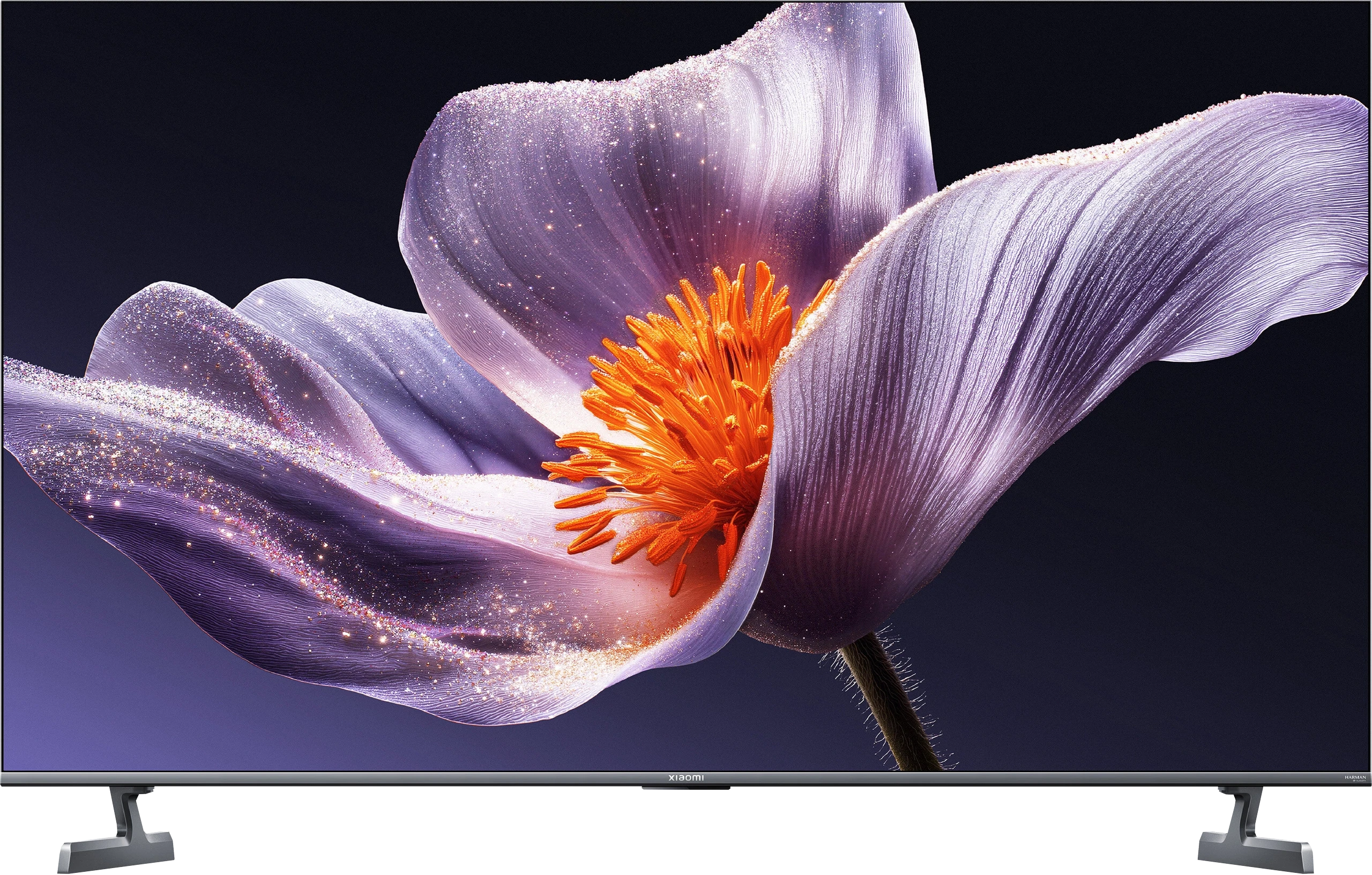
Panel type: LCD VA
Resolution: 3840x2160
System: Google TV
Model year: 2024
Complete the survey to find out the result

Resolution: 3840x2160
System: Google TV
Model year: 2025
Complete the survey to find out the result

Overall rating
6.4
7.2
Movies and series in UHD quality
6.4
6.7
Classic TV, YouTube
6.2
6.3
Sports broadcasts (TV and apps)
6.2
6.4
Gaming on console
7.4
7.7
TV as a computer monitor
3.0
8.6
Watching in bright light
5.4
7.4
Utility functions
6.5
7.2
Apps
9.6
9.6
Sound quality
6.0
7.1
Complete the survey to find out what fits your preferences
Advantages
High native contrast
Smooth tonal transitions
120 Hz panel
Advanced features for gamers
Low input lag
Harman/Kardon signature audio
Good black levels and contrast (SDR)
Very high peak brightness (great for a bright living room)
Complete package for gamers (144 Hz panel, HDMI 2.1, VRR)
Extremely low input lag in SDR mode (below 10 ms)
Surprisingly good, powerful sound (Branded by Harman Kardon)
Support for Dolby Atmos and DTS:X
Rich Google TV system (with AirPlay and Chromecast)
Proper compatibility with PC (clear fonts and 288Hz mode)
Outstanding value for the offered specification
Disadvantages
Poor viewing angles
Dolby Vision IQ does not work properly
Average panel response time
Poor font readability when connected to PC
Local dimming algorithms practically do not work in HDR content
Useless Dolby Vision Gaming mode (input lag approx. 100 ms)
Poorly implemented HGiG mode
Highly visible banding (colour banding) in dark scenes
Very poor upscaling and digital image processing
Google TV system can "struggle"
Our verdict
Is it worth buying the Xiaomi S Pro 2026? The answer to this question is quite complicated. Let's start with what is really great about this television. First of all, the Xiaomi S Pro 2026 has an excellent price-to-specification ratio. We get a Mini LED panel with very high brightness that performs exceptionally well in a sunlit living room. Additionally, it has a fast refresh rate of 144 Hz (and even 288 Hz) and a full package for gamers: two HDMI 2.1 ports, support for VRR, and remarkably low input lag (below 10 ms). If we mainly watch "regular" content and play games, this is truly a fantastic screen. Even the built-in 30W speakers are surprisingly good and support Dolby Atmos. Unfortunately, there is also a second, very problematic side to this model. In short: the software. We have the impression that Xiaomi has provided us with excellent "parts," but could not make them work together correctly. The biggest issue is the HDR mode – the primary reason for buying a television today. For unknown reasons, the television in HDR mode (HDR10, Dolby Vision) does not manage its dimming zones well. As a result, the black that should be deep becomes gray or navy blue, like in a standard LCD television. There are also other software faults such as the terrible implementation of HGiG or the fact that the Dolby Vision mode for gamers is useless due to the enormous input lag (100 ms). Additionally, the television has very poor capabilities for digital image processing. So how can this be summarised in terms of price? In its price range, the Xiaomi S Pro 2026 crushes the competition in terms of specifications. Other televisions at this price point are usually basic LCD models without dimming and often only with a 60 Hz panel. The question is therefore: what is more important to you? If you are simply looking for a very bright and inexpensive television for watching TV during the day and gaming, and you are willing to calibrate it – you will be very satisfied with it. However, if you are looking for a television to enjoy stunning HDR in films and games right out of the box, you will be terribly disappointed with this model. In that case, in our opinion, it is better to pay a bit extra for a basic OLED television or a more refined Mini-LED model from the competition.
TV appearance








Contrast and black detail
6.2/10
7.4/10
Local dimming function: No
Local dimming function: Yes, number of zones: 532 (28 x 19)
Contrast:

Result
5,200:1

Result
7,200:1

Result
7,700:1

Result
8,100:1

Result
4,800:1

Result
1,001,650:1

Result
52,600:1

Result
17,900:1

Result
17,200:1

Result
10,150:1
Halo effect and black detail visibility:


Sharp FQ8, thanks to its VA panel, offers a very high native contrast ratio, achieving an impressive score of 8100:1 in tests with cinematic test patterns. It is worth noting that this result stands out very positively against competing models and is very rarely encountered. This means that the image gains an appropriate depth in scenes with distinct differences between light and dark elements, which is particularly important when assessing contrast and black quality, as these are key criteria in image analysis. The Sharp FQ8 panel uses direct backlighting (Direct LED), however, it does not support local dimming. In this price category, this is understandable, although it affects the depth of black and clarity in darker scenes like that from the film Sicario 2, which can be seen below.
Let's get to the point, which is what is most important in the Mini LED panel: black levels and contrast. The Xiaomi S Pro 2026 is built on a VA matrix, which already promises deep blacks from the start. Adding to that is the Mini LED backlighting with a very large number of local dimming zones. In the 65-inch variant we tested, we counted as many as 532. This is a solid number that should provide precise control over the backlighting. It should be noted that this number is proportional to the size – by choosing the smaller 55-inch variant, there will be correspondingly fewer zones, and in larger models, more.
So, how does the black level perform on the S Pro 2026? The answer is complex.
Overall, it is really quite good, and we see a clear improvement compared to the problematic model from 2025. As you can see from our measurement charts, the results are sometimes spectacular. In most of the film scenes we measured in SDR (standard dynamic range), the contrast could be confidently described as very good and even comparable to designs three times as expensive. Well, it could be... and here we come to the paradox of this model. The issue is how the television manages the zones in scenarios other than SDR. As soon as we feed the television a higher-quality signal, such as an HDR series or Dolby Vision from streaming platforms (Netflix, HBO Max or Disney+), something strange happens. We have the undeniable impression that the television suddenly... forgets that it has been equipped with local dimming zones at all. As can be seen in our video below, the black levels in such scenes resemble more shades of dark grey or navy blue. Additionally, there is a subtle flickering of the entire screen. This is a level we would expect from televisions entirely devoid of a local dimming system. It seems that Xiaomi decided to fix one, but key, flaw of last year's 2025 model over the course of a year. And they succeeded – we no longer have the annoying "zone disco", the image is stable. It's just a shame that when consuming content of the highest quality (HDR), this entire advanced system becomes completely useless.
HDR effect quality
5.3/10
6.3/10
Luminance measurements in HDR:

Result
384 nit

Result
399 nit

Result
465 nit

Result
461 nit

Result
463 nit

Result
809 nit

Result
526 nit

Result
1033 nit

Result
469 nit

Result
718 nit
Scene from the movie “Pan” (about 2800 nits)


Scene from the movie “Billy Lynn” (about 1100 nits)


Static HDR10


Dynamic: Dolby Vision
Dynamic: Dolby Vision


HDR luminance chart:
Xiaomi S Pro 2026
HDR luminance
Sharp FQ8
HDR luminance
Sharp FQ8 can achieve a maximum brightness exceeding 450 nits, which is a satisfactory result. Although it may seem that this value is not impressive, it still places it among the top televisions in this price range. In our opinion, this is also a value from which we will feel the richness of the image and the operation of any metadata, which cannot be said about darker devices. The television supports the advanced HDR format known as Dolby Vision. It is also equipped with DOLBY Vision IQ technology, which stands out for its ability to automatically adjust brightness and image colours based on the lighting conditions in the room. Unfortunately, it has been poorly implemented, resulting in significant inaccuracies such as artificial brightening of the image. Therefore, we do not recommend using this technology in this model. Additionally, the colour gamut coverage is around 94% thanks to the use of quantum dot technology, enabling vibrant and realistic colours. This set of features ensures that the image is not only intense but also full of details.
When it comes to HDR quality, the Xiaomi S Pro 2026 is undoubtedly a very bright television. On our synthetic measurement patterns, we were able to generate peak brightness of around 1400 nits. This result is not only very good but truly spectacular, considering the price of this model. However, as we always emphasise, for our editorial team, measurements and the experiences from the content viewed on a daily basis - from films and series - are more important. So let's analyse how the Xiaomi performs with film material. The result is, unfortunately, quite mixed. When very bright scenes appear on screen, the S Pro 2026 really shows its full potential and can achieve a real 800-1000 nits in bright elements. Moreover, even smaller objects can "burn" the eyes - in scenes from the film Sicario 2, small metal elements of the helicopter were truly vivid. The problem is that - and here the story comes full circle back to our contrast assessment - in such scenes we cannot count on absolutely cinematic black. In our opinion, this compromise is too great; high visibility of details in bright areas should not come at the cost of such a significant boost to black levels. And although the HDR effect itself can make a stunning impression here, it is essential to remember that when very challenging, mixed scenes appear on screen, we might feel a slight disappointment. Exactly the one we mentioned in the previous paragraph regarding issues with dimming in HDR mode. As a consolation, it is worth adding that the S Pro 2026 has been equipped with an additional PFS filter (similar in function to a QLED layer), which effectively broadens the colour gamut coverage. As a result, measurements showed DCI-P3 coverage reaching up to 94%. This gives us confidence that in most colourful scenes, the image will appear rich and appropriately saturated.
Factory color reproduction
4.2/10
4.1/10


Factory Mode
After calibration


Factory Mode
After calibration
The colour reproduction test in Sharp FQ8 was conducted in film mode, which out of the box offers the best visual capabilities, providing viewers with a colour experience closest to reality. Nevertheless, it cannot be described as exceptional, as there are still some shortcomings that affect the overall picture quality. Colour reproduction in Sharp FQ8 for HD content demonstrates significant issues with white balance. On the graph, the red line clearly rises, indicating excessive dominance of the red colour. This is also confirmed by tests using colour samples, which show that many colours deviate towards red. For example, in a scene from a film featuring a child, the image is very warm and unnaturally red. Similar difficulties occur with 4K HDR content, where there is also noticeable excessive presence of the red colour. It is worth noting this, especially for those who value faithful colour reproduction.
Regarding contrast for SDR, at the beginning of the gamma graph there is a strange characteristic, suggesting issues with reproduction. Subsequently, the entire line is below the reference line, indicating that the television does not achieve appropriate brightness and contrast values in standard content. Meanwhile, the EOTF curve for 4K HDR shows significant discrepancies. Such fluctuations indicate difficulties in maintaining consistent brightness reproduction, leading to unpleasant visual effects when viewing HDR content.
Of course, all our measurements were carried out in "Film" mode, which is typically the best and most accurate choice we get straight out of the box. It needs to be said plainly: although it is the best mode, it is still very far from ideal. Firstly, the television has a clear tendency to impart a cool, bluish tint to the image – this is due to a poorly set white balance. Additionally, there is the issue of how the S Pro 2026 manages its brightness straight out of the box, which results in an overly vivid image. These two flaws contribute to truly significant colourimetric errors (Delta E). In HDR content, they were able to exceed our anticipated error scale of "10" by twofold (meaning values close to 20). As a reminder – the threshold for perceivable error by the human eye is a Delta E value of around 3. Results at the level of 20 indicate that the image significantly deviates from what the director intended.
Color reproduction after calibration
7.8/10
7.2/10




After calibration, for SDR content, the white balance on Sharp FQ8 has been significantly improved, and all lines have come much closer to the reference line. Of course, they are not perfectly straight, but it's hard to expect better results from a television in this price range; they are really very good. Improving white balance means that colours are more natural and accurately reproduced, which positively impacts the overall visual experience. In terms of gamma, the strange jump at the beginning of the graph has not been eliminated, however, after this error, the entire line is much closer to the expected effect.
For HDR content, the white balance is somewhat worse compared to SDR content, but it is still significantly better than before calibration. It is worth noting that the improvement in white balance in HDR contributes to a more consistent and pleasant perception of colours, even though there may still be shortcomings. Regarding the EOTF graph and the associated contrast, our specialists noted that the lack of control over dynamic tone mapping settings hindered the achievement of significant improvement in this area. This leads to uneven brightness representation.
Despite the shortcomings resulting from the inability to adjust settings for dynamic tone mapping, Sharp FQ8 has gained a new perspective after proper calibrations. The improved white balance and better colour reproduction in SDR mode make the image more natural and pleasing to the eye. Although there are still areas for improvement, especially in HDR content, the television offers satisfying visual experiences, making it a noteworthy choice in its price range.
So how does the S Pro 2026 perform after our calibration procedure? We have to admit that after calibration, the television becomes a really very pleasant device for watching everyday content. As you can see in the graphs, in HD (SDR) materials, both white balance and gamma values have been brought to nearly perfection. Most importantly, colourimetric errors have become practically unnoticeable to the human eye. In this scenario, the S Pro 2026 is simply an excellent television that, after professional calibration, can provide a lot of enjoyment from watching. However, it is worth clearly noting – our efforts have not helped much in 4K HDR mode. Despite the calibration, the television still interprets the image quite strongly "in its own way," which is clearly visible in the measurement of the EOTF curve (brightness tracking). It’s a bit of a shame, as it shows that the problem lies not in the panel itself, but in the software. Underdeveloped image management algorithms in HDR content can, unfortunately, rule out this television for many more discerning users.
Smoothness of tonal transitions
8.8/10
6.9/10












When it comes to the fluidity of tonal transitions, Sharp FQ8 television performs excellently, presenting very nice transitions in all the tested movie scenes. Colours blend harmoniously, which significantly impacts the picture quality. The only aspect that can be pointed out is a slightly noticeable gradation towards black and in the scene with a colourful sunset against the mountains. However, these minor imperfections do not detract from the overall positive visual experience that the television offers.
Let us now turn to the analysis of tonal transitions, that is, the fluidity with which the television can render transitions between closely related shades. In the case of the Xiaomi S Pro 2026, the image that emerges from this is distinctly ambivalent. On the one hand, we have bright gradations. When scenes with a blue sky or other smooth transitions in the light areas of the image appear on the screen, the S Pro 2026 handles them exemplary. They look perfectly smooth, with no visible artefacts.
Unfortunately, the situation changes dramatically as soon as dark scenes take the stage on the screen. Frankly speaking – they look really poor. Instead of a smooth tonal transition in the darkness, the screen very clearly shows the joins of colours and unappealing "stepping" of the gradients. This is very noticeable in darker films or games and can effectively ruin the viewing experience.
Image scaling and smoothness of tonal transitions
6.5/10
4.5/10
Smooth transition function


Image without overscan on the SD signal


The "10-bit colour reproduction" feature in Sharp FQ8 performs reasonably well, as we can see in the image with bulbs that shows slight connections between grey shades. For the best results, it is recommended to set medium, which does not reveal issues with grain smoothing or blurring of essential image elements. Alternatively, the "low" setting also proves to be safer and delivers positive effects.
As for upscaling, the Sharp FQ8 television plays back video without overscan, allowing for full use of the screen. The branches shown in the image are noticeably jagged, while the edges of the trousers appear without clear jaggedness, positively affecting the overall image quality. Additionally, the television offers an AI Super Resolution feature, which artificially sharpens jagged elements, enhancing their clarity.
Let's start with the issue we raised in the previous paragraph: can the television actually fix the problem of dreadful tonal transitions in dark scenes? Theoretically, yes – in the menu, we find a feature with the promising name "Colour Contour Removal." Well, "theoretically." Unfortunately, in practice, this setting – regardless of which of the three power levels is chosen – yielded absolutely no real results. So we are dealing with a feature that, in practice, only exists in the menu. Moving on to the quality of upscaling (scaling the image from a lower resolution to 4K), unfortunately, we have more bad news for you. The S Pro 2026 performs very poorly at this task. Interestingly, the phenomenon of "overscan" (slight cropping of the image) is not a major issue here. The fact is that the television simply displays a very raw, unprocessed image. Its attempt to upscale the signal to a higher resolution looks simply lacklustre and lacks any form of "intelligent" improvement. There is no denying it – the entire digital image processing is the real Achilles' heel of this model.
Blur and motion smoothness
7.2/10
7.5/10

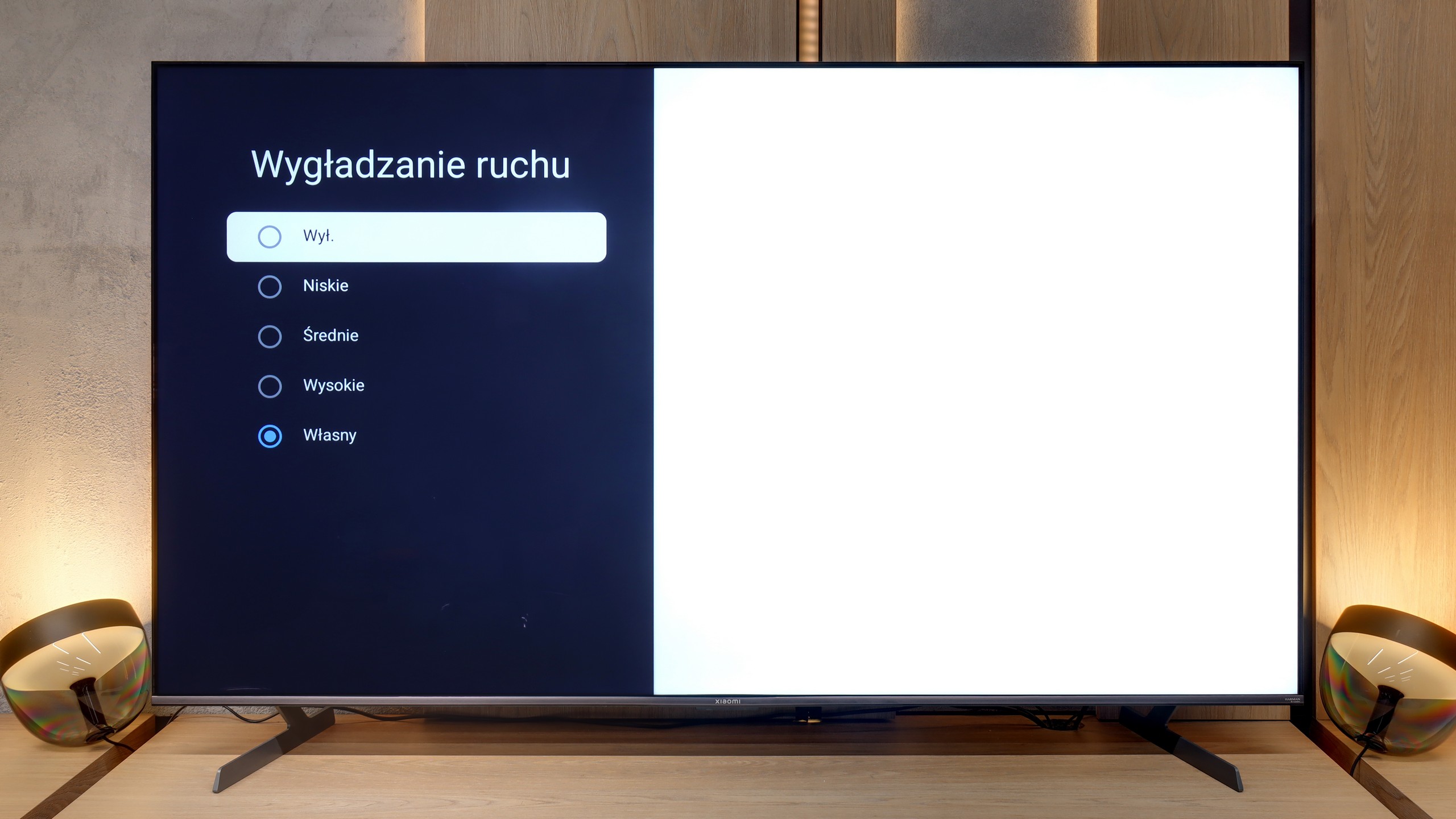
Blur (native resolution, maximum refresh rate):






Smużenie ():
Smużenie (1080p@288Hz):



Sharp FQ8 is equipped with a 120 Hz panel, with the possibility of achieving 144 Hz on PC, which in theory should translate to smooth motion rendering. The television offers functions for improving the smoothness of films and reducing motion blur, which is important for more dynamic content. However, the lack of Black Frame Insertion (BFI) technology combined with an average response time of the panel does not yield positive results. The effect is slight blurring of moving objects, and this may be more noticeable when watching sports or during intense gaming.
On paper, the S Pro 2026 specification looks impressive. The television is equipped with a native 144 Hz panel, with the ability to display images at up to 288 Hz in a dedicated gaming mode. These are amazing results, but what interested us most, in the context of everyday use, was how the television handles motion blur and how the image looks at 120 Hz. After all, this is the frequency used by consoles like the PlayStation 5 and Xbox Series X/S, and it is desired by sports fans. Generally, the panel "holds up". The matrix is sufficiently fast to meet these challenges, and objects displayed at native 120Hz fluidity are shown correctly. As for the software, the television is equipped with motion smoothing technology; however, with a key caveat – it works only for input signals up to 60 Hz. This means it is primarily suitable for traditional television, films, and series. Thanks to this, we can adjust the fluidity of the image to our own preferences – from a very smooth, "theatrical" approach to setting the slider to "zero" and maintaining a fully cinematic character.
Console compatibility and gaming features
7.1/10
8.2/10
- ALLM
- VRR
- VRR range48 - 144Hz48 - 144Hz
- Dolby Vision Game Mode
Yes, high input lag
Yes, high input lag
- Correct implementation of HGIG
- 1080p@120Hz
- 1440p@120Hz
- 4K@120Hz
- Game bar

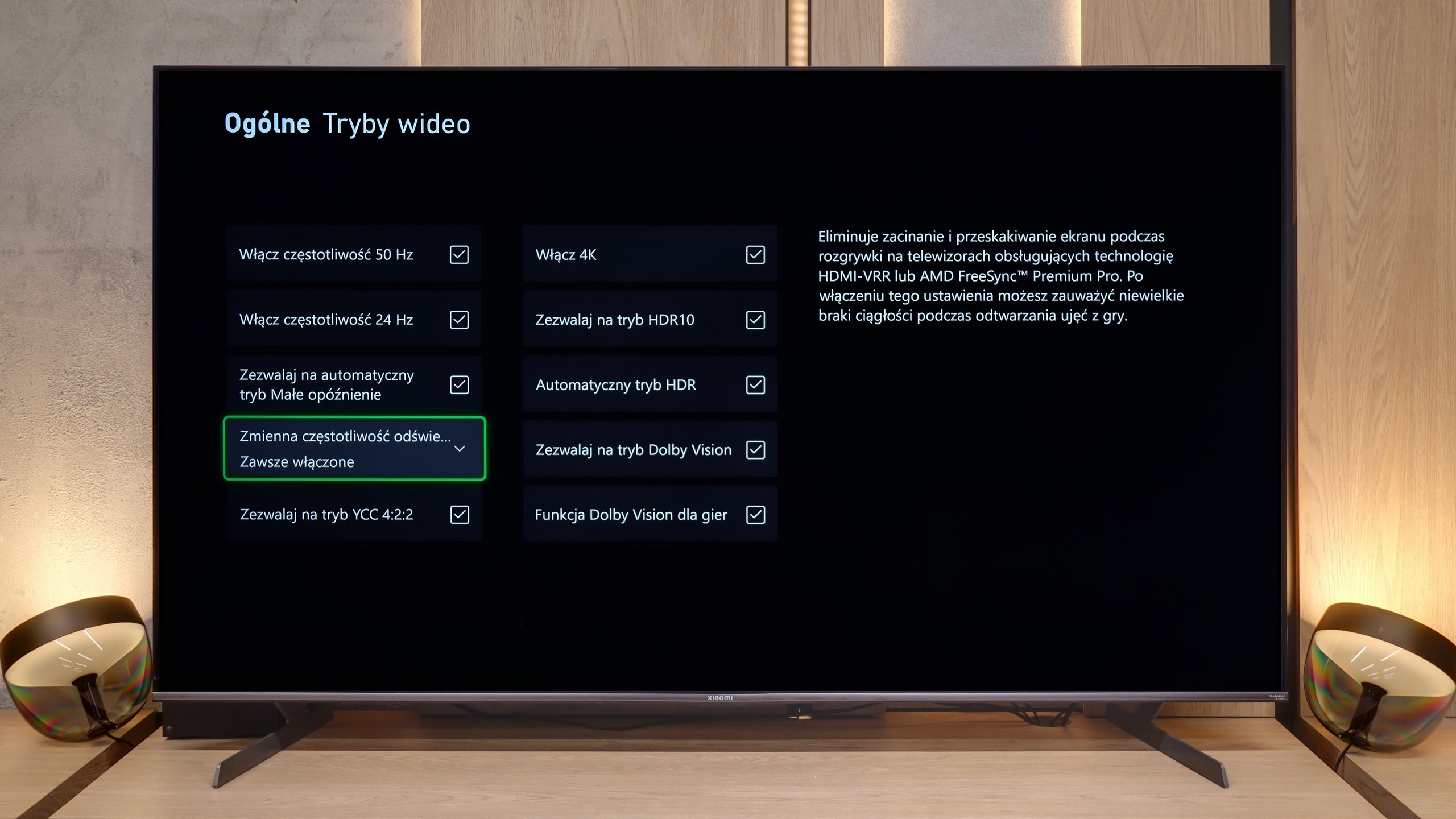

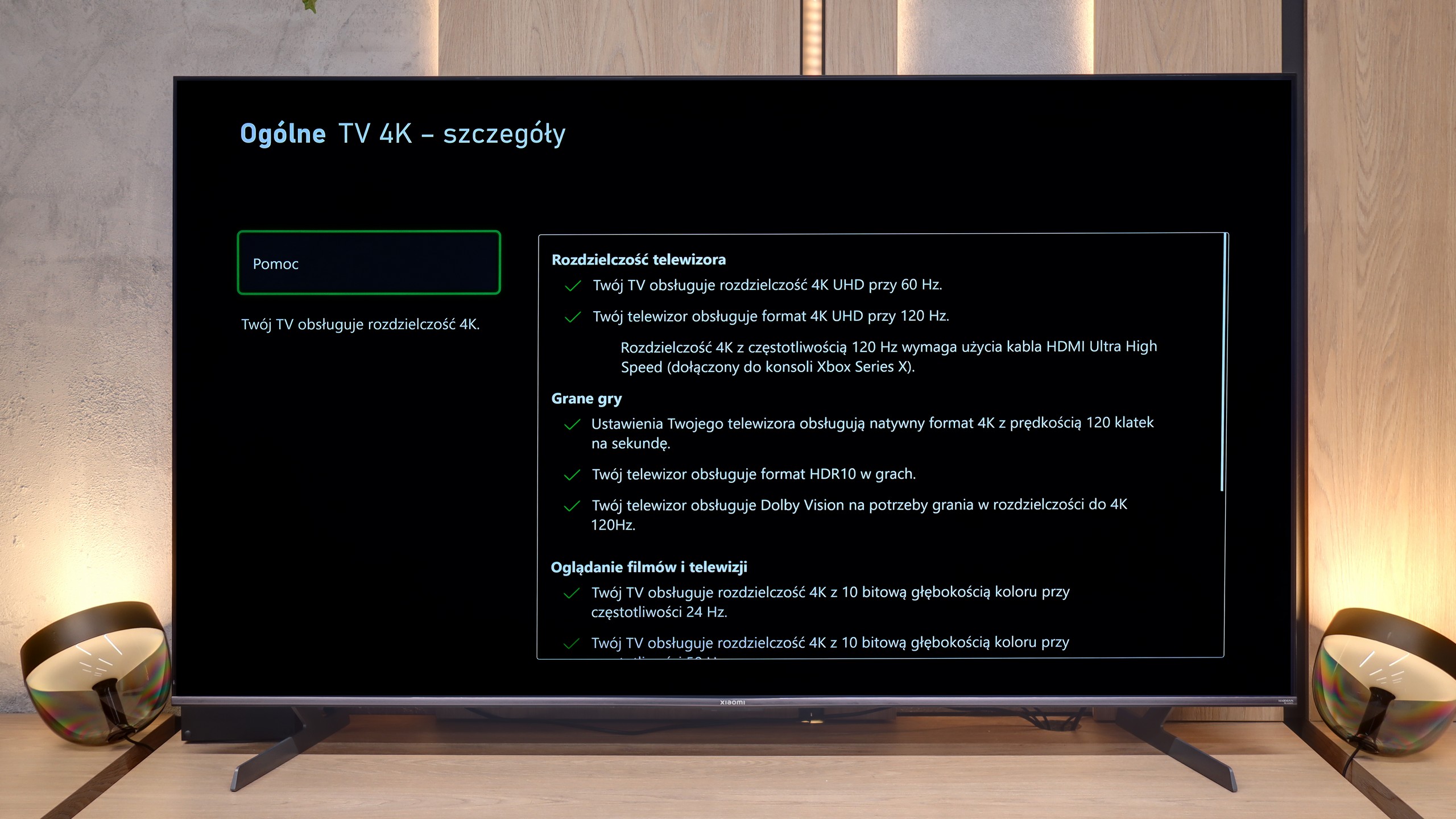



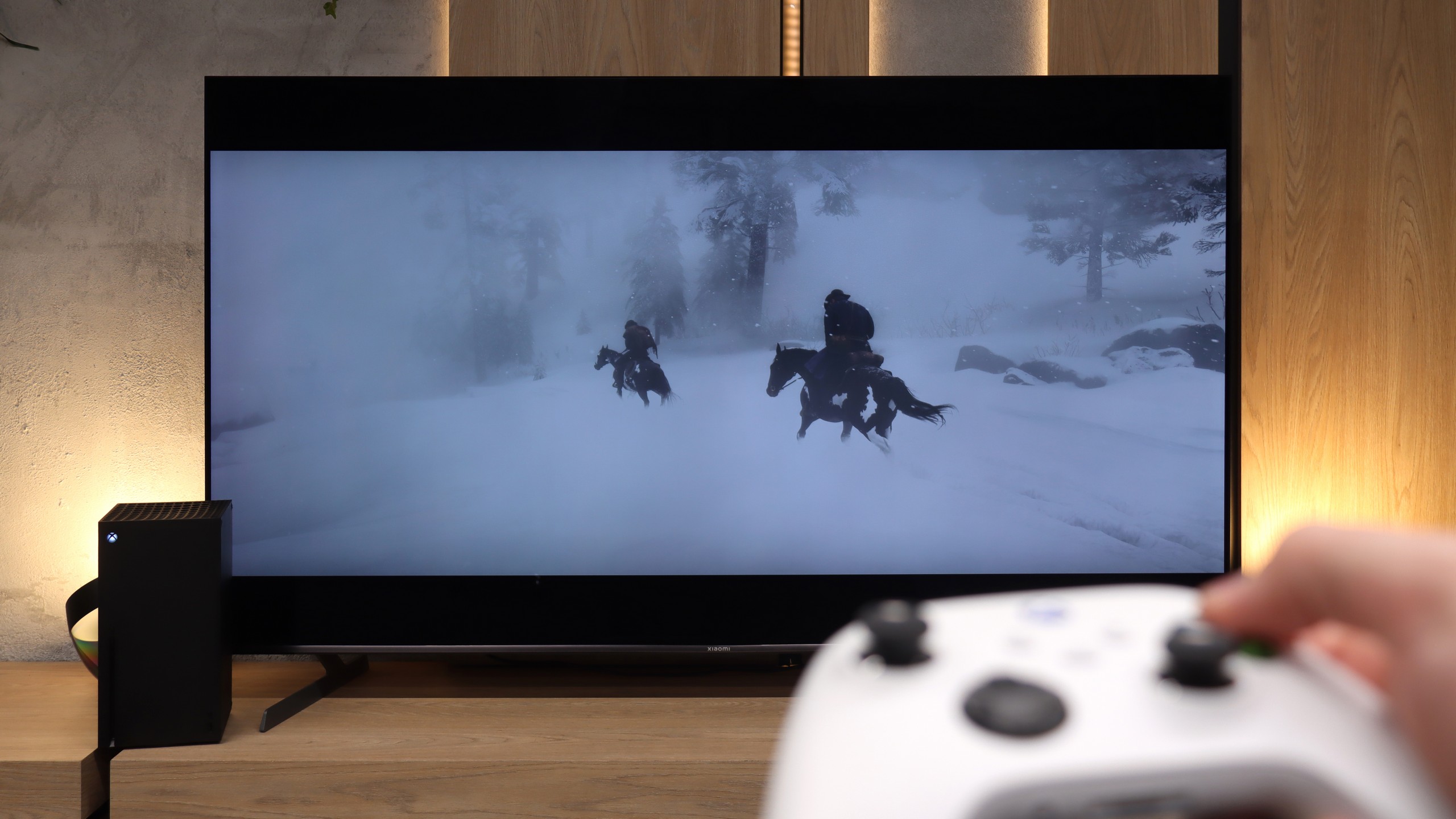
Sharp FQ8 offers several significant features dedicated to gamers that can enhance the gameplay experience. First and foremost, the television is equipped with HDMI 2.1, which comes with certain advantages. ALLM (Auto Low Latency Mode) switches the television to a mode with minimal input lag when a gaming device is detected. VRR (Variable Refresh Rate) reduces screen stutter by adjusting the refresh rate to the number of frames generated by the console or computer, providing smoother experiences, especially in dynamic games. Additionally, the television supports G-Sync technology, which synchronises the image with the graphics card, eliminating stuttering and screen tearing. Despite these advantages, FQ8 also has some limitations. The lack of support for HGiG (HDR Gaming Interest Group) means that the television does not optimise dynamic range for HDR games. The Dolby Vision mode, although theoretically offering better image quality in games supporting this format, suffers from very high input lag.
For gamers, the Xiaomi S Pro 2026 is almost an ideal proposition on paper. It is equipped with two HDMI 2.1 ports, which allow us to unlock (although these options are somewhat hidden in the menu) the full package of features: ALLM, VRR and, crucially, the ability to work in 4K at 144 Hz. This last feature should particularly please the owners of powerful PCs. The television also has something resembling a gamer panel – and although it's hard to call it a fully-fledged "Gamebar", it serves its purpose by displaying key information. It’s just a shame that in its default form, it obscures a relatively large portion of the screen.
The biggest issue we have with this model, however, concerns how the S Pro 2026 handles games in HDR mode. To put it bluntly: it doesn’t handle it well at all. Due to the television having a poorly implemented HGiG feature (the HDR tone mapping standard for games), it is very easy to "overexpose" the image during initial HDR calibration on the console. If someone is unaware of this software flaw and follows the on-screen instructions, they will simply set the image incorrectly, resulting in burnt-out details in the bright areas. Another major problem is the Dolby Vision mode for games. While it does work, it generates such a high input lag that it becomes noticeable in dynamic titles. (You can check all our lag measurements in the paragraph below). In summary: Generally speaking, this is a really very good screen for gamers, but with one small caveat. We would rather avoid using HDR mode on it – unless we decide to manually set the brightness bar on the console "by eye", completely ignoring the instructions from the console’s pictogram.
Input lag
9.1/10
8.5/10
SDR
HDR
Dolby Vision
Generally, the input lag in Sharp FQ8 is very good, achieving below 16 ms for each tested resolution, making the television suitable for gaming, providing smooth and quick response. However, when Dolby Vision mode is enabled and the refresh rate is 60 Hz, the input lag increases sharply. This significantly worsens responsiveness, which can be particularly troublesome in dynamic games where precision and speed of reaction are crucial.
We move on to one of the most important measurements for gamers, namely signal delay (input lag). Overall, the Xiaomi S Pro 2026 performs excellently here. Generally, in game mode, the lag is very low. With 120 Hz content (from consoles or PCs), we easily achieved results below 10 ms. These are truly outstanding results and, in practice, completely imperceptible for most people, even those very sensitive to lag. Unfortunately, there is one "but" that constitutes the biggest flaw of this model in gaming. This is concerning the Dolby Vision Gaming mode. When this mode is activated, input lag rises to an astronomical level of around 100 ms. At this value, the delay between our movements on the controller (we tested on an Xbox console) and what is displayed on the screen becomes really significant and irritating. Therefore, our recommendation is simple: we absolutely do not recommend using the Dolby Vision Gaming mode on this television.
Compatibility with PC
3/10
8.6/10

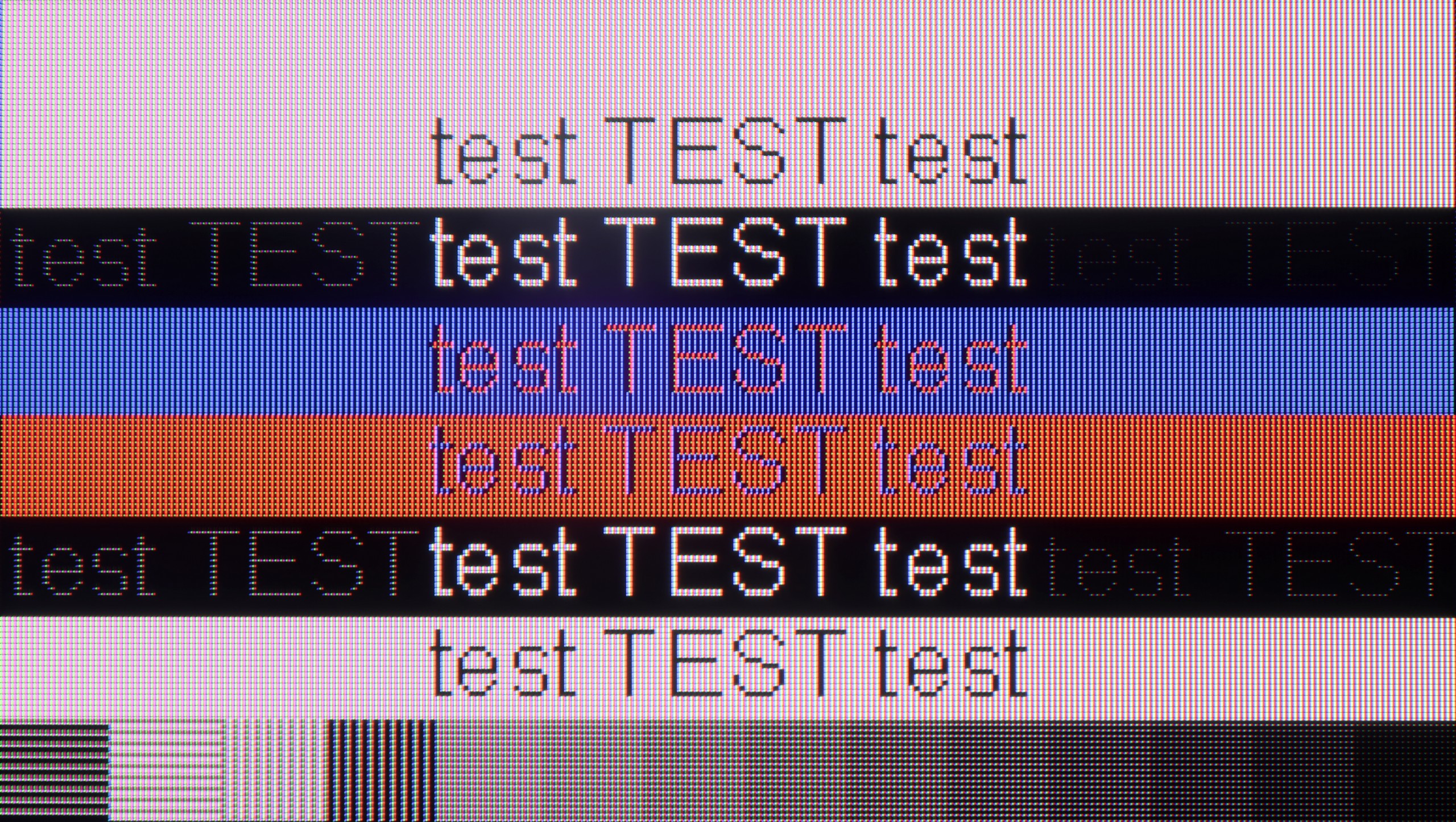
The cooperation of the television Sharp FQ8 with the PC unfortunately leaves a lot to be desired, despite the low input lag. The main problems arise from the lack of full support for chroma 4:4:4 at a resolution of 4K and 120 Hz, which results in blurry text and details in computer graphics. Additionally, the applied subpixel arrangement of BGR, instead of standard RGB, makes fonts less readable and can appear fuzzy.
Generally, when it comes to gaming, the S Pro 2026 is a fantastic screen for PC owners. It offers a refresh rate of up to 288 Hz at Full HD resolution or a full 144 Hz at 4K. All of this, supported by technologies such as AMD FreeSync or G-Sync, really caters to very demanding gamers. And what about "desktop" work? Here we have good news. Although the displayed font may not be perfectly sharp (like on a dedicated PC monitor with an IPS panel), it is presented in a really pleasant and readable manner. This is due to the proper implementation of Chroma 4:4:4 sampling, which ensures that text is clear and there are no issues with coloured fringes.
Viewing angles
2.1/10
3.7/10
The viewing angles on the Sharp FQ8 are quite poor, which is a result of the use of a VA panel. When watching from a wider angle, the television significantly loses brightness, and colours quickly lose their saturation. As a result, the image becomes washed out, and details less clear, which can be problematic if you plan to watch television with a larger group or from different positions in the room.
As for a television equipped with a VA panel, we must admit that the decrease in brightness when deviating from the screen's axis is relatively small in the Xiaomi S Pro 2026. However, one must remember the second, crucial aspect – colour saturation significantly degrades at angles. This is typical behaviour for televisions with VA panels that do not have additional coatings to widen viewing angles. Is this a downside of this television? Probably not. It's simply a characteristic, the price we have to pay for the key qualities of a VA panel in the form of its high native contrast.
Daytime performance
5.4/10
7.4/10

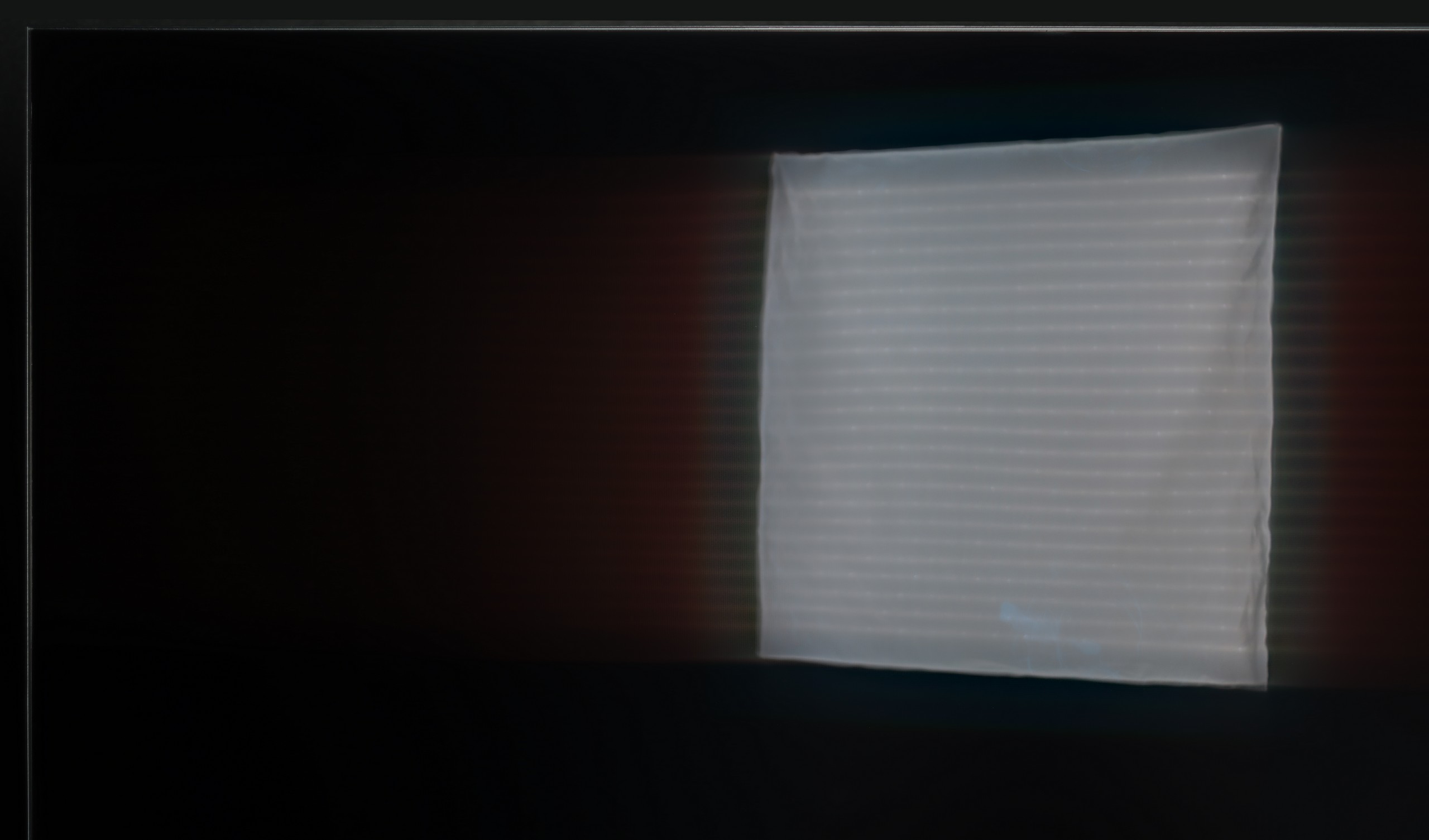


Panel brightness
Average luminance SDR
Xiaomi S Pro 2026: 771 cd/m2
Sharp FQ8: 440 cd/m2
Sharp FQ8 performs quite well in daytime lighting conditions. The panel reaches a brightness level of 440 nits, which, combined with the satin screen coating, results in satisfactory visibility even in bright light. Importantly, the television does not have issues displaying the colour black during the day, which ensures that darker scenes remain readable and do not lose depth, despite the bright surroundings.
Due to its very high peak brightness, the Xiaomi S Pro 2026 performs exceptionally well in brightly lit rooms. In most scenarios, it is capable of "cutting through" even very strong room lighting. However, it should be noted that the matrix used here averages out in terms of reflecting light. This means that in darker areas of the image, or when the television is displaying a dark scene, direct reflections (e.g. the reflection of a window or lamp) may be annoying. Nevertheless, the S Pro 2026, as a television for a bright living room, will perform very well indeed, thanks to its tremendous brightness.
Panel details
Subpixel Structure:

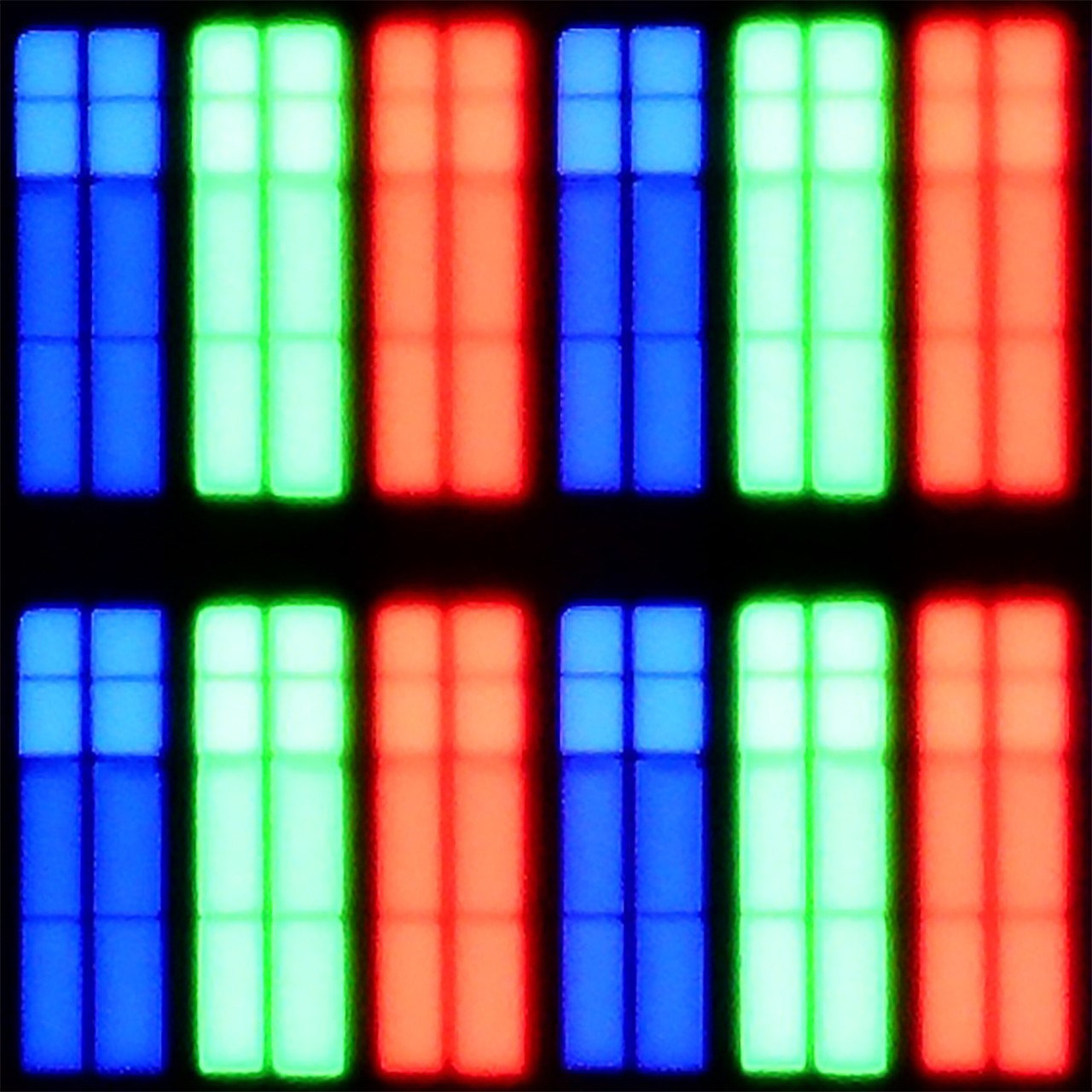
Panel uniformity and thermal imaging:
Sharp FQ8
Xiaomi S Pro 2026
TV features
6.5/10
7.2/10
- HDMI inputs2 x HDMI 2.0, 2 x HDMI 2.1 48Gbps1 x HDMI 2.0, 2 x HDMI 2.1 48Gbps
- Other inputsRCA (Chinch)
- OutputsToslink (Optical audio), eARC (HDMI), ARC (HDMI), Mini-Jack (Headphones)Toslink (Optical audio), eARC (HDMI), ARC (HDMI), Mini-Jack (Headphones)
- Network InterfacesWi-Fi 2.4GHz, Wi-Fi 5GHz, Ethernet (LAN) 100MbpsWi-Fi 2.4GHz, Wi-Fi 5GHz, Ethernet (LAN) 100Mbps
- TV receptionDVB-T, DVB-T2, DVB-S, DVB-S2, DVB-CDVB-T, DVB-T2, DVB-S, DVB-S2, DVB-C
Classic features:
- Recording to USB (terrestrial TV)
- Recording programming
- Picture in Picture (PiP)
- RF remote control (no need to aim at the screen)
- Backlit remote control
- Teletext
- Audio only mode
- Bluetooth headphones support
- Simultaneous Bluetooth headphones & TV audio
Smart features:
- AirPlay
- Screen mirroring (Windows Miracast)
- Voice search
- Voice search in native language
- Ability to connect a keyboard and mouse



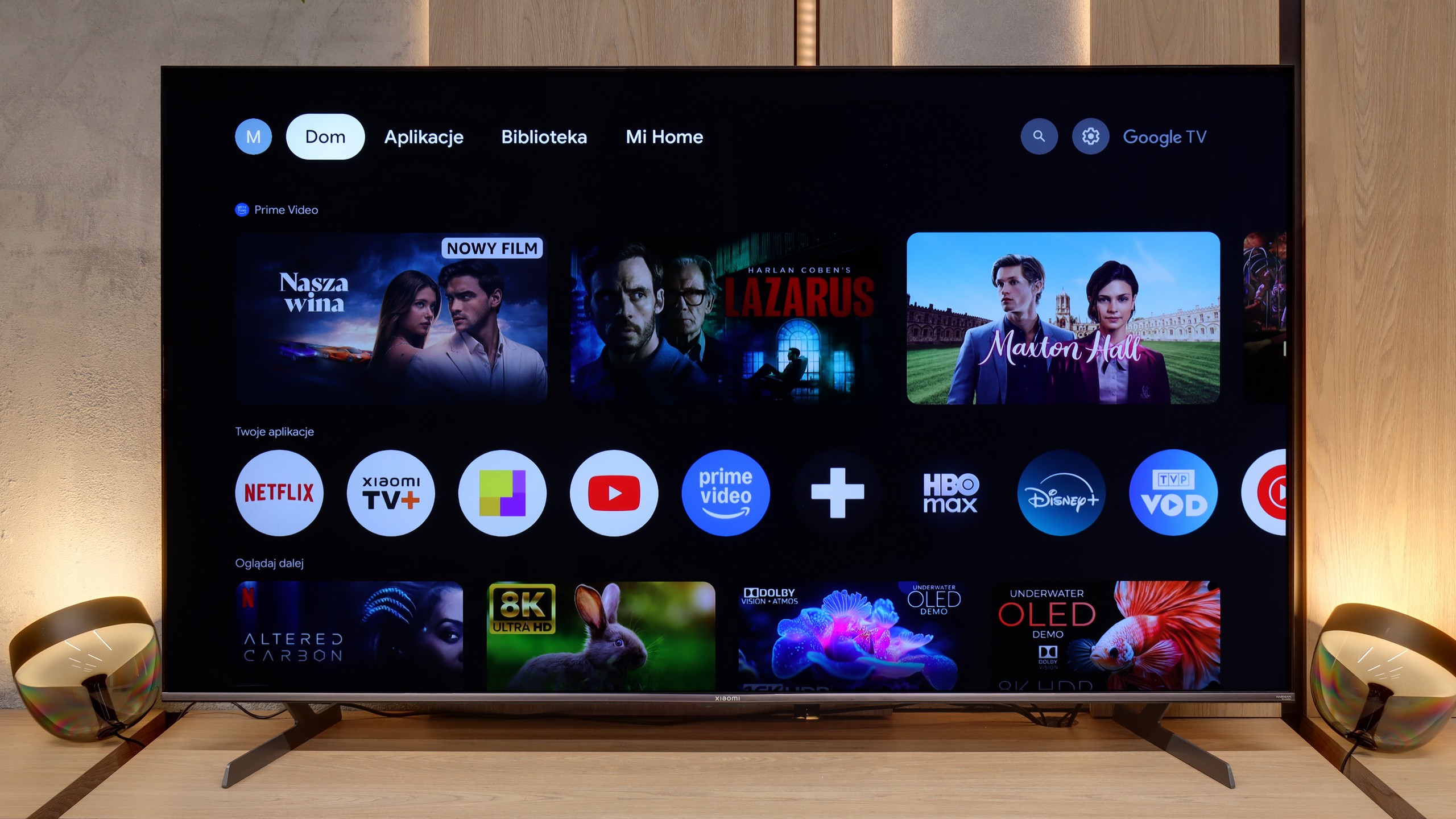
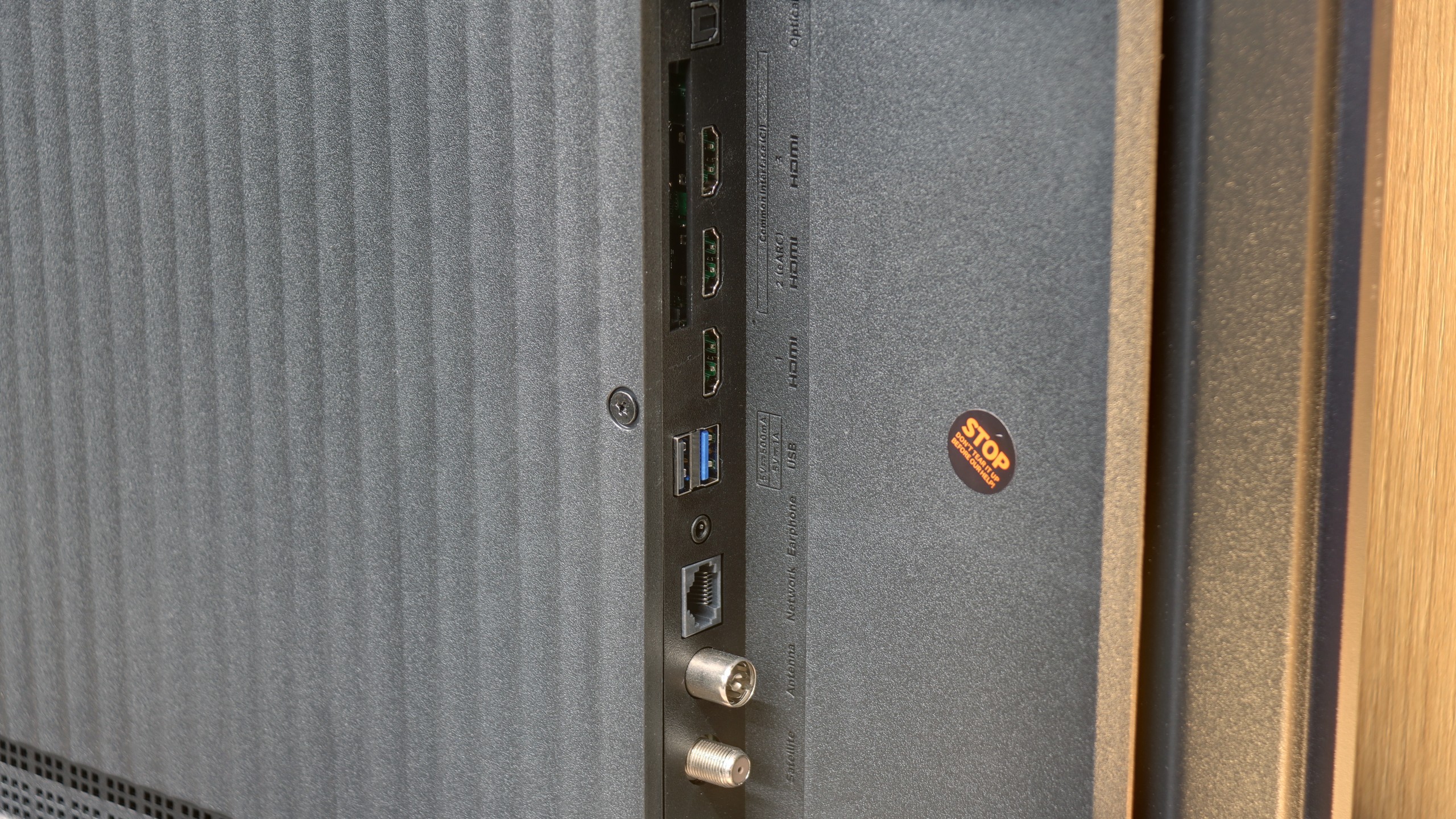

Sharp FQ8 is equipped with a modern Google TV system that provides access to a wide range of applications, such as Netflix, YouTube, Prime Video and Disney+. Additionally, the television supports voice control in Polish, making navigation and quick access to content easier. The FQ8 also offers the ability to connect multiple devices, such as keyboards, mice, Bluetooth headphones, and other accessories.
Despite these advantages, the television has certain limitations. The lack of television recording features and picture-in-picture (PiP) support may be a downside for those using these options. Additionally, Apple device users may feel the lack of compatibility with AirPlay, making it difficult to easily stream content from an iPhone or iPad to the television.
Operating System (Google TV)
The enormous advantage of the Xiaomi S Pro 2026 is undoubtedly the presence of the Google TV system. This gives us access to a gigantic library of applications – we can find literally everything here, from leading VOD platforms to niche players. The system also offers a plethora of useful features, such as a built-in Chromecast, support for AirPlay and Screen Mirroring, as well as an efficiently functioning voice search. The Google TV system itself is great, but one must take a slight grain of salt with its implementation by Xiaomi. During our tests, it occasionally exhibited what could be described as a "breathlessness." Animations could stutter slightly, and the response to commands was not immediate. This is certainly not the level of fluidity that we are accustomed to with top-tier, significantly more expensive models equipped with more powerful processors.
Television Features and Connectivity
How does the S Pro 2026 perform as a "regular" television? Unfortunately, here we have less good news. In terms of traditional television viewing, we can only commend this model mainly for having a convenient remote control with a numeric keypad – which (surprisingly) is not a standard today. However, this is where the conveniences end. We will not find either USB recording functionality (PVR) or a PiP (Picture-in-Picture) option. On the plus side, we appreciate the extensive Bluetooth connectivity options. We were able to connect external devices to the television, such as wireless headphones, a keyboard, or a mouse, without any issues, which significantly simplifies operation.
Playing files from USB
9.4/10
6.8/10
Supported photo formats:
Maximum photo resolution:


Thanks to the Google TV system, Sharp FQ8 offers great flexibility in playing files from USB. Users can install various applications for image and sound playback, such as VLC or MX Player, which enables the television to handle most popular file formats with ease. Whether it's movies, music, or photos, support for multiple formats ensures comfortable and hassle-free use of multimedia from external storage devices.
The built-in, default media player in the Xiaomi S Pro 2026 is – given the capabilities of the Google TV system – simply weak. Its biggest drawback is the fact that it does not support characters other than those from the standard alphabet. As a result, it does not display, among others, Polish fonts in subtitles or file names. Fortunately, as we have already mentioned, the heart of the television is Google TV. This system allows for the quick installation of an external, significantly better player, such as VLC or Kodi. For this television, we recommend installing an alternative player immediately after the first start-up.
Apps
9.6/10
9.6/10














































Sound
6/10
7.1/10
- Maximum volume91dB82dB
- Dolby Digital Plus 7.1
- Dolby True HD 7.1
- Dolby Atmos in Dolby Digital Plus (JOC)
- Dolby Atmos in Dolby True HD
- DTS:X in DTS-HD MA
- DTS-HD Master Audio
The sound assessment of the Sharp FQ8 is of course subjective, yet there are a few aspects worth highlighting. The television is equipped with a soundbar directed straight towards the user, branded by Harman/Kardon. Although it is not a full-fledged soundbar or home theatre system, the speaker arrangement clearly enhances the audio experience, delivering a clearer and more direct sound, which will certainly be a beneficial solution for everyday television viewing. It is also worth noting that the television was capable of achieving very high volume levels, which will definitely assist those who have some sort of hearing difficulty. The only remark we encountered was related to the sound processing by Dolby, which caused quite noticeable sound distortions and artificial clipping.
We have to admit that the S Pro 2026 has pleasantly surprised us. The television is equipped with a 30W speaker system, which, for its class, sounds really very good. There is even a noticeable hint of bass, and the mid and high tones are quite well balanced. Of course, all of this is within the capabilities of what the television's speakers can deliver, yet it is a level we did not expect from such a relatively inexpensive model. A huge plus is also the support for top audio technologies. The television is capable of decoding not only the very popular Dolby Atmos format but also the recently quite rarely seen DTS:X, which we mainly find on Blu-ray discs.
Sound Quality Test
No sound test video
Acoustic Measurements
No acoustic data
82dBC (Max)
75dBC
